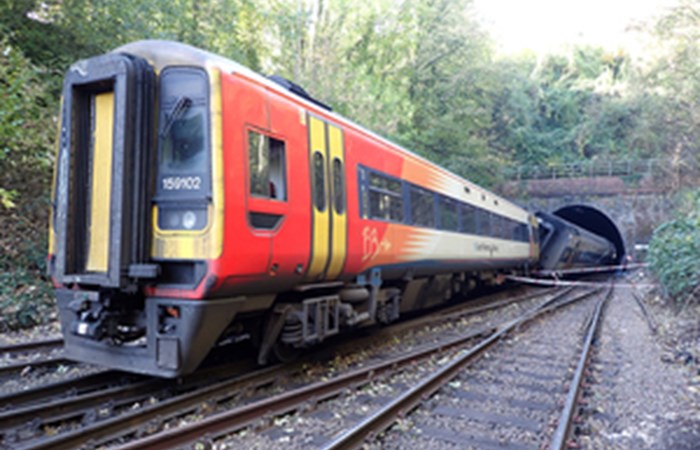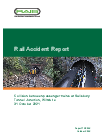Rail Accident Investigation Branch

Summary
At around 18:43 hrs on 31 October 2021, train reporting number 1L53, the 17:20 hrs South Western Railway passenger service from London Waterloo to Honiton, passed a red signal and collided with the side of train 1F30, the 17:08 hrs Great Western Railway passenger service from Portsmouth Harbour to Bristol Temple Meads. At the point of collision, train 1L53 was travelling at approximately 52 mph (84 km/h) and train 1F30 at 20 mph (32 km/h). The collision took place at Salisbury Tunnel Junction, which is on the immediate approach to Fisherton Tunnel, near Salisbury in Wiltshire.
The impact of the collision caused the front two carriages of train 1L53 and the rear two carriages of train 1F30 to derail. Both trains continued some distance into Fisherton Tunnel before they came to a stop. Thirteen passengers and one member of railway staff required treatment in hospital as a result of the accident, which also caused significant damage to the trains and railway infrastructure involved. A potentially far more serious collision between train 1L53 and an earlier train travelling in the opposite direction was avoided by less than a minute.
The causes of the accident were that wheel/rail adhesion was very low in the area where the driver of train 1L53 applied the trains brakes, that the driver did not apply the trains brakes sufficiently early on approach to the signal protecting the junction to avoid running on to it, given the prevailing low level of adhesion, and that the braking systems of train 1L53 were unable to mitigate this very low adhesion.
The level of wheel/rail adhesion was very low due to leaf contamination on the railhead, and had been made worse by a band of drizzle that occurred immediately before the passage of train 1L53. This leaf contamination resulted from the weather conditions on the day of the accident, coupled with an increased density of vegetation in the area which had not been effectively managed by Network Rails Wessex route. Network Rails Wessex route had also not effectively managed the contamination on the railhead with either proactive or reactive measures.
RAIBs investigation found that a probable underlying factor was that Network Rails Wessex route did not effectively manage the risks of low adhesion associated with the leaf fall season. RAIB also found that South Western Railway not effectively preparing its drivers for assessing and reporting low adhesion conditions was a possible underlying factor.
RAIB has also made two safety observations. These relate to the application of revised design criteria for the Train Protection and Warning System and the assessment of signal overrun risk and how this accounts for high risk of low adhesion sites. Two issues were found relating to the severity of the consequences. These were a loss of survival space in the drivers cab of train 1L53, and the jamming of internal sliding doors, which obstructed passenger evacuation routes.
Since the accident, Network Rail has reviewed its training and competence framework for off track staff at network level, and is also reviewing its adhesion management standards. Network Rails Wessex route is reviewing its arrangements for proactively responding to reports of low adhesion, including how it undertakes railhead treatment.
South Western Railway has made changes relating to training and briefing of its drivers to ensure information on autumn arrangements has been effectively briefed and understood.
Network Rail and South Western Railway have also jointly updated their annual autumn leaf fall working arrangements to ensure that sites at high risk of low adhesion are identified, reassessed, managed and monitored.
The Rail Safety and Standards Board has revised the rail industry standard that provides guidance for the rail industry regarding the management of low adhesion. Cross-industry working groups have also issued revised guidance regarding low adhesion.
In December 2021, the safety authority for the mainline railway in Great Britain, the Office of Rail and Road, issued an improvement notice to Network Rails Wessex route requiring it to improve its vegetation management and its assessment and control of low adhesion risks.
Recommendations
As a result of the investigation, and accounting for the work done by the industry since the accident, RAIB has made ten recommendations. Seven of these recommendations are made to Network Rail. These relate to: a review of the processes, standards and guidance documents relating to the management of leaf fall low adhesion risk; the training and competence of staff dealing with vegetation management and seasonal delivery; responses to emerging and potential railhead low adhesion conditions; management of railhead treatment regimes; assessment of the risk of overrun at signals which have a site at high risk of low adhesion on their approach; and a review of the retrospective application of design criteria for the Train Protection and Warning System.
One recommendation is made to South Western Railway to review and improve its arrangements for training and briefing drivers to ensure that they are able to effectively identify areas of low adhesion and report them as appropriate.
One recommendation is made to the Rail Delivery Group in consultation with train operators and the Rail Safety and Standards Board regarding the review of technologies other than sanding systems and wheel slide protection to improve braking in low adhesion conditions.
One recommendation is made to Porterbrook, Eversholt and Angel Trains regarding the design of the internal sliding doors on class 158 and 159 carriages.
Andrew Hall, Chief Inspector of Rail Accidents said:
This was a very serious accident and the first time since our inception in 2005 that RAIB has investigated the collision of two passenger trains travelling at significant speed. Fourteen people were taken to hospital, including two who were seriously injured.
The phrase leaves on the line may cause some to smile. But the risks associated with leaves being crushed onto the top of rails by the pressure of trains wheels, resulting in a slippery layer, is very real and long known. As with many accidents, this one resulted from a combination of many different circumstances coming together, both in the time before the accident and on the day. As a result, the barriers put in place to avoid this type of event did not work effectively.
Accidents like this are thankfully very rare, but it is vital that we learn the lessons when things do go wrong. Along with action already taken by industry, the ten recommendations we have made today will minimise the chances of an accident like this happening again.
Notes to editors
-
The sole purpose of RAIB investigations is to prevent future accidents and incidents and improve railway safety. RAIB does not establish blame, liability or carry out prosecutions.
-
RAIB operates, as far as possible, in an open and transparent manner. While our investigations are completely independent of the railway industry, we do maintain close liaison with railway companies and if we discover matters that may affect the safety of the railway, we make sure that information about them is circulated to the right people as soon as p

